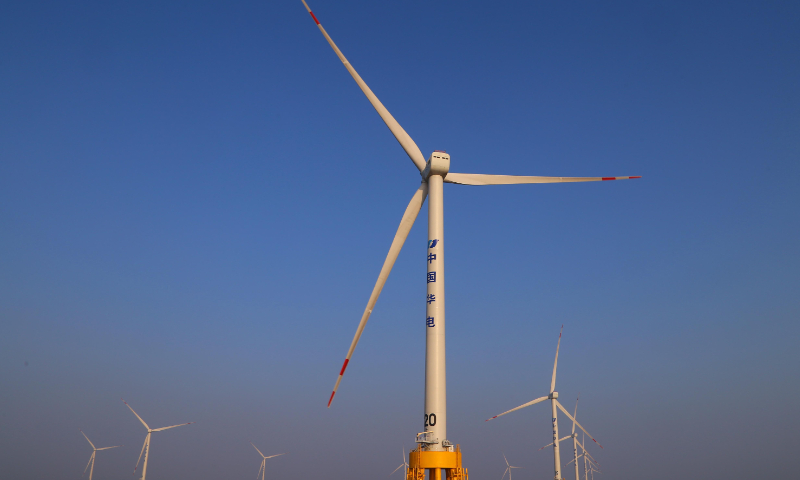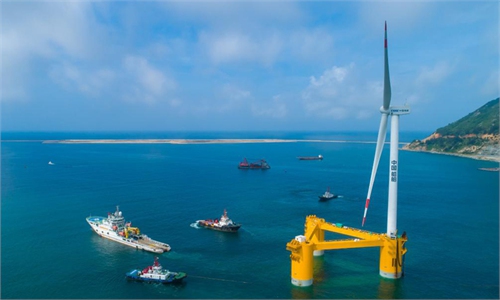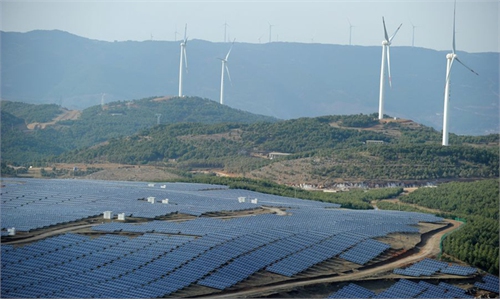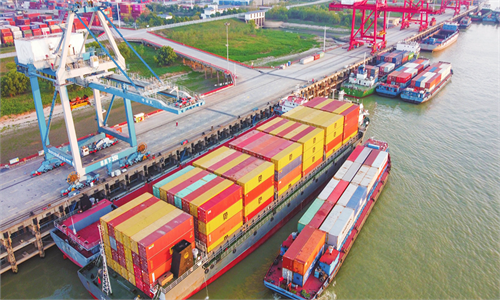China ratchets up renewable energy development, with SOEs spearheading low-carbon transition
Central SOEs spearheading low-carbon transition: analysts

Windmills stand at the No.1 wind farm in Yuhuan, East China's Zhejiang Province, on November 27, 2022. In recent years, Yuhuan has made full use of its abundant offshore wind resources to vigorously develop the wind power industry, and it has sent green energy to thousands of households. Photo: cnsphoto
Construction of diverse renewable energy projects are accelerating across China, with large centrally administered state-owned enterprises (SOEs), major players in the rapidly growing sector, stepping up activity after the Spring Festival holidays.China Huaneng Group, the country's biggest coal power generator, announced in a recent meeting that it will pivot to operating renewable energy projects with a total capacity of more than 30 million kilowatts in 2023. Its investment is likely to reach 100 billion yuan ($14.66 billion).
A total of 152 new-energy projects involving 29 provinces and regions are underway or at preparatory stage. The projects cover clean energy bases in the country's north, offshore wind farm in the east and integrated bases of hydropower and wind farm in the southwest, plus scattered projects in the central and eastern regions.
Huaneng signed contracts with 13 other SOEs in January, bringing them into its new-energy intelligent operation and maintenance platform.
A total of 494 projects were signed in early February in Shenyang, capital of Northeast China's Liaoning Province, with those related to new energy and energy conservation accounting for 27.8 percent.
Bidding to build offshore wind farms has become active. Since the beginning of February, relevant agencies have announced winning bids for the procurement of wind turbines for a large new energy project in the port of Huizhou, South China's Guangdong Province.
Those deals have activated both the upstream and downstream segments of the renewable energy industrial chain, with prices of polysilicon, silicon wafers, cells and other raw materials in the photovoltaic sector all increasing.
And, projects operational rate is ticking up, amid expectations that demand will be gradually released after the Spring Festival holidays, according to an analysis by Essence International.
China's large SOEs are committed to leading the country's new energy transition, and they are the largest investors in the sector, and their active bidding bodes well for project construction in 2023, said Fitch Ratings.
Also, many local governments have set eyes on developing clean energy, deemed as a driving force for driving local economic growth as the nation has vowed to achieve the "dual carbon" goals on time.
Renewable energy development is a focus of many local governments' annual work reports. East China's Shandong Province proposed a target of renewable energy installation capacity to reach 80 million kilowatts this year. North China's Inner Mongolia Autonomous Region, one of the country's largest coal producers, pledged to fast track renewable energy projects.
"The region will grasp this historic opportunity brought by renewable energy development, by speeding up construction of whole industrial chain in an attempt to build a new 'Industrial Inner Mongolia' ," Chen Zheng, the deputy head of the region's energy department, said on February 7.
The region has made continuous progress during recent years in promoting green transition by giving priority to the construction of large solar and wind energy bases. By 2025, the installed capacity for renewable energy generation in the region will exceed coal-fired power, according to the action plan.
During the next four decades, the proportion of wind power, photovoltaic and other renewable energy generation in China is expected to exceed 65-70 percent, as the country unswervingly pushes forward the green transition, said Lin Boqiang, director of the China Center for Energy Economics Research at Xiamen University.
"Since the installed capacity of renewable energy represented by wind power and photovoltaic projects will usher in explosive growth in the medium and long term, we should actively promote the construction of large new energy bases in the northwest," Lin said.
China saw steady growth in renewable energy capacity in 2022, data from the National Energy Administration (NEA) showed. As of the end of last year, the installed capacity of renewable energy hit 1.21 billion kilowatts, accounting for 47.3 percent of the total installed power generation capacity, surpassing coal.
In 2022, China generated 2.7 trillion kilowatts of electricity from renewable energy sources, which accounted for 31.6 percent of total electricity consumption, equivalent to the entire power consumption of the EU in 2021, according to the NEA data.



